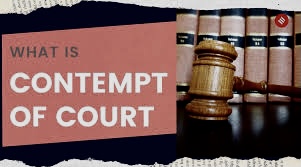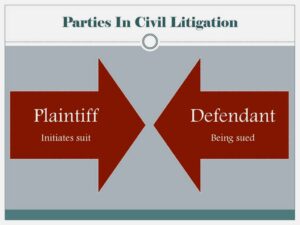
This is a short summary of the law of contempt of court that is a hundreds of years old power of the judiciary and part of the courts method of upholding it’s dignity and effect.
Most of the summary relates to civil court cases and contempt for them. the most common would probably be family/divorce matters.
I made two contempt of court applications over the years in matrimonial matters and both times the court accepted an apology from the “guilty” party as an end to the matter, while my client wanted them incarcerated and flogged.
It wasn’t worth the time and money.
This is not to say that the courts are lenient as they certainly can and will enforce matters where there is a flagrant contempt of a court order, especially after warnings have been given.
The test summarized by the Supreme Court of Canada in Carey v. Laiken, 2015 SCC 17:
Contempt of court “rest[s] on the power of the court to uphold its dignity and process. The rule of law is directly dependent on the ability of the courts to enforce their process and maintain their dignity and respect”: United Nurses of Alberta v. Alberta (Attorney General), 1992 CanLII 99 (SCC), [1992] 1 S.C.R. 901, at p. 931.
It is well established that the purpose of a contempt order is “first and foremost a declaration that a party has acted in defiance of a court order”: Pro Swing Inc. v. Elta Golf Inc., 2006 SCC 52, [2006] 2 S.C.R. 612, at para. 35, cited in Bell ExpressVu Limited Partnership v. Torroni, 2009 ONCA 85, 94 O.R. (3d) 614, at para. 20.
The common law has developed to recognize two forms of contempt of court: criminal contempt and civil contempt.
The distinction, which the parties to this appeal accept, rests on the element of public defiance accompanying criminal contempt: see, e.g., United Nurses, at p. 931; Poje v. Attorney General for British Columbia, 1953 CanLII 34 (SCC), [1953] 1 S.C.R. 516, at p. 522. With civil contempt, where there is no element of public defiance, the matter is generally seen “primarily as coercive rather than punitive”: R. J. Sharpe, Injunctions and Specific Performance (2nd ed. (loose-leaf)), at ¶ 6.100.
However, one purpose of sentencing for civil contempt is punishment for breaching a court order: Chiang (Trustee of) v. Chiang, 2009 ONCA 3, 305 D.L.R. (4th) 655, at para. 117.
Courts sometimes impose substantial fines to match the gravity of the contempt, to deter the contemnor’s continuing conduct and to deter others from comparable conduct: Sharpe, at ¶ 6.100.
Civil contempt has three elements which must be established beyond a reasonable doubt: Prescott-Russell Services for Children and Adults v. G. (N.) (2006), 2006 CanLII 81792 (ON CA), 82 O.R. (3d) 686 (C.A.), at para. 27; College of Optometrists, at para. 71; Bhatnager v. Canada (Minister of Employment and Immigration), 1990 CanLII 120 (SCC), [1990] 2 S.C.R. 217, at pp. 224-25; Jackson v. Honey, 2009 BCCA 112, 267 B.C.A.C. 210, at paras. 12-13;
These three elements, coupled with the heightened standard of proof, help to ensure that the potential penal consequences of a contempt finding ensue only in appropriate cases: Bell ExpressVu, at para. 22; Chiang, at paras. 10-11.
1. The first element is that the order alleged to have been breached “must state clearly and unequivocally what should and should not be done”: Prescott-Russell, at para. 27; Bell ExpressVu, at para. 28, citing with approval Jaskhs Enterprises Inc. v. Indus Corp., 2004 CanLII 32262 (Ont. S.C.J.), at para. 40. This requirement of clarity ensures that a party will not be found in contempt where an order is unclear: Pro Swing, at para. 24; Bell ExpressVu, at para. 22. An order may be found to be unclear if, for example, it is missing an essential detail about where, when or to whom it applies; if it incorporates overly broad language; or if external circumstances have obscured its meaning: Culligan Canada Ltd. v. Fettes, 2010 SKCA 151, 326 D.L.R. (4th) 463, at para. 21.
2. The second element is that the party alleged to have breached the order must have had actual knowledge of it: Bhatnager, at p. 226; College of Optometrists, at para. 71. It may be possible to infer knowledge in the circumstances, or an alleged contemnor may attract liability on the basis of the wilful blindness doctrine (ibid.).
3. The party allegedly in breach must have intentionally done the act that the order prohibits or intentionally failed to do the act that the order compels: Sheppard v. Sheppard (1976), 1976 CanLII 710 (ON CA), 12 O.R. (2d) 4 (C.A.), at p. 8. The meaning of this element is one of the main points in contention on appeal and I will turn to consider it in more detail momentarily.
The contempt power is discretionary and courts have consistently discouraged its routine use to obtain compliance with court orders: see, e.g., Hefkey v. Hefkey, 2013 ONCA 44, 30 R.F.L. (7th) 65, at para. 3. If contempt is found too easily, “a court’s outrage might be treated as just so much bluster that might ultimately cheapen the role and authority of the very judicial power it seeks to protect”: Centre commercial Les Rivières ltée v. Jean Bleu inc., 2012 QCCA 1663, at para. 7. As this Court has affirmed, “contempt of court cannot be reduced to a mere means of enforcing judgments”: Vidéotron Ltée v. Industries Microlec Produits Électroniques Inc., 1992 CanLII 29 (SCC), [1992] 2 S.C.R. 1065, at p. 1078, citing Daigle v. St-Gabriel-de-Brandon (Paroisse), 1991 CanLII 3806 (QC CA), [1991] R.D.J. 249 (Que. C.A.).
Rather, it should be used “cautiously and with great restraint”: TG Industries, at para. 32. It is an enforcement power of last rather than first resort: Hefkey, at para. 3; St. Elizabeth Home Society v. Hamilton (City), 2008 ONCA 182, 89 O.R. (3d) 81, at paras. 41-43; Centre commercial Les Rivières ltée, at para. 64.




